November 2025
The global adblue oil market size was accounted for 76.58 billion liters in 2024 and is expected to be worth around USD 148.37 billion liters by 2034, growing at a compound annual growth rate (CAGR) of 6.84% during the forecast period 2025 to 2034. The implementation of sustainability initiatives by global governments is fueling market growth in the current period.
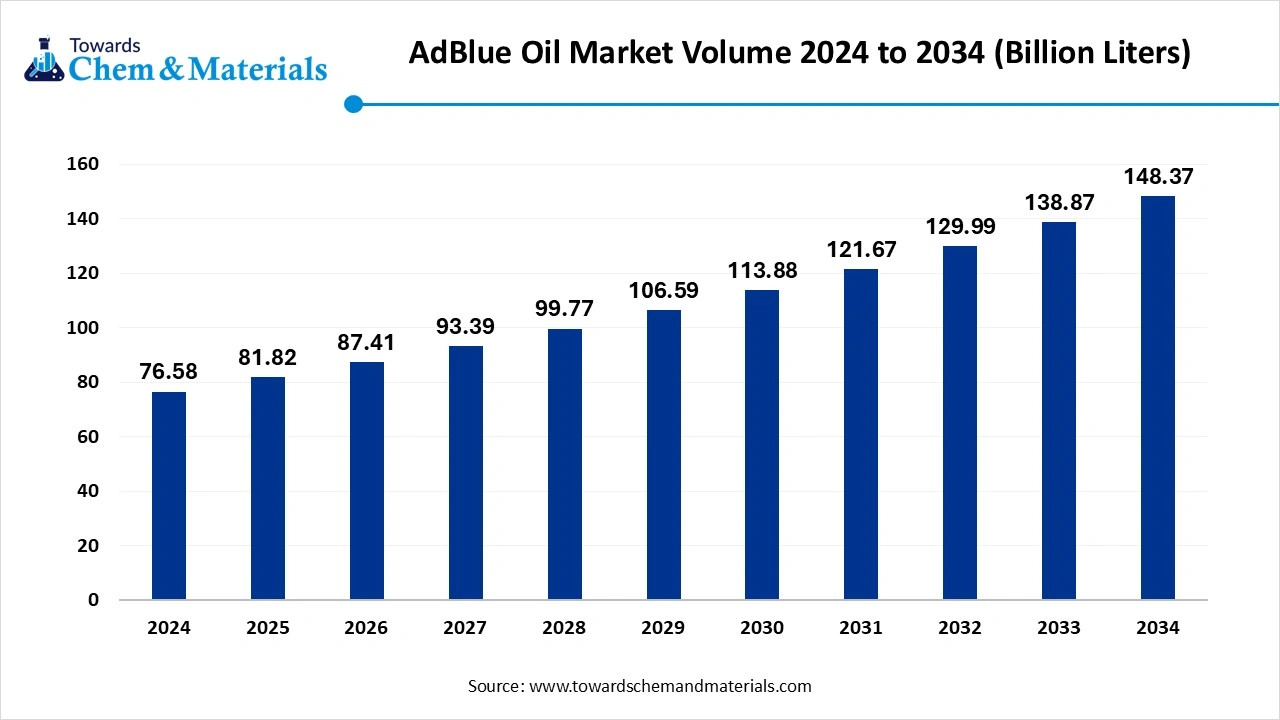
The AdBlue oil market is undergoing a rapid phase of growth akin to the increasing regulatory push for reduced vehicular emissions across global markets. As governments implemented stricter environmental regulations, the demand for selective catalytic reduction (SCR) technology and, by extension, AdBlue, has witnessed consistent growth in recent years. This urea-based diesel exhaust fluid plays a critical role in lowering nitrogen oxide emissions, specifically in heavy-duty vehicles and off-road machinery. Also, the market is gaining momentum across transportation, agriculture, and construction sectors, where diesel engine usage remains high.
Manufacturers are rapidly increasing their production capacities and distribution networks to meet rising regional demands, particularly in regions such as Europe, North America, and Asia-Pacific. Furthermore, digital tracking and quality monitoring technologies are increasingly being integrated into the supply chain, ensuring efficiency and product integrity. With emission standards becoming stronger, AdBlue has become central to achieving sustainable mobility goals, making it a key focus area for automotive and fuel supply chains.
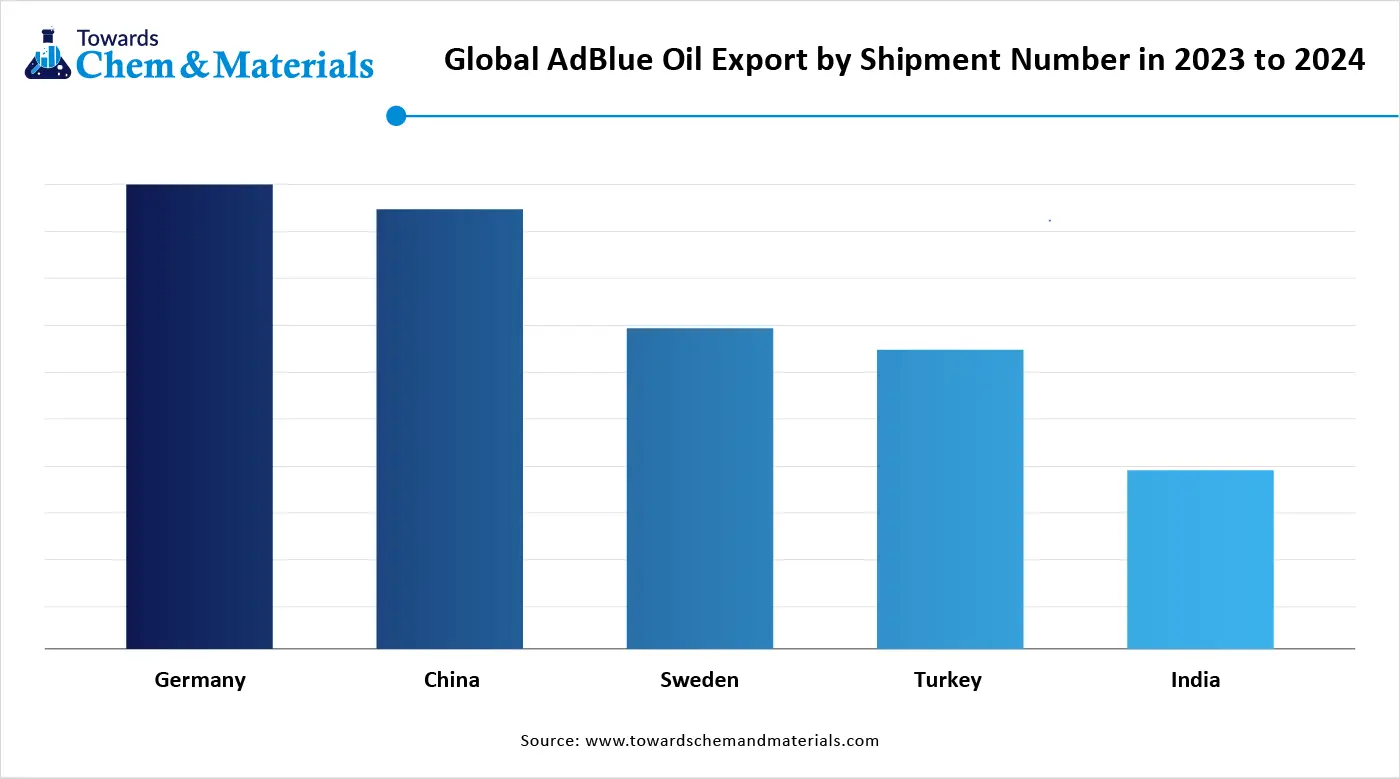
The increasing application of emission control regulations, particularly those aimed at curbing nitrogen oxide emissions from diesel engines, is driving the AdBlue oil market in the current period. As international standards such as Euro 6 and others take effect, vehicle manufacturers are increasingly adopting SCR technology, which requires a consistent supply of AdBlue in recent years. This regulation-driven transformation is encouraging operators and fuel distributors to invest in AdBlue infrastructure and storage facilities, contributing to industry growth in the current period. Also, the commercial vehicle sector, from logistics to public transportation, is accelerating the adoption of emission-reducing systems to comply with sustainability mandates. Furthermore, the regulatory landscape is not only increasing demand but also compelling innovation in fluid formulation, packaging, and delivery systems in recent years.
| Report Attribute | Details |
| Market Volume in 2025 | 81.82 Billion Liters |
| Expected Volume by 2034 | 148.37 Billion Liters |
| Growth Rate from 2025 to 2034 | 6.84 % |
| Base Year of Estimation | 2024 |
| Forecast Period | 2025 - 2034 |
| Dominant Region | North America |
| Segment Covered | By Type, By Application, By Region |
| Key Companies Profiled | BASF SE, Bosch Limited, Brenntag S.p.A., CF Industries Holdings, Inc., CrossChem Limited, Graco Inc., Komatsu, Mitsui Chemical, Inc., Nandan Petrochem Ltd., Nissan Chemical Company, S.C. OMV PETROM S.A., Shell plc, STOCKMEIER Group, TotalEnergies, Yara |
The rapid growth of commercial and logistics fleets across global markets is expected to create lucrative opportunities for AdBlue oil market during the forecast period. As emission regulations become stronger, specifically in developing countries, fleet operators are under pressure to adopt SCR (Selective Catalytic Reduction) technologies that depend upon AdBlue. This shift can open significant growth doors for manufacturers to increase production capacities, establish supply partnerships, and enhance distribution networks in the future, as per the observation.
The increasing integration of IoT-enabled dispensing and monitoring systems is anticipated to create lucrative opportunities for manufacturers in the coming years. As the market increases, industries are moving toward digital tracking of AdBlue usage to improve operational efficiency, reduce wastage, and meet regulatory compliance. Also, the ability to offer real-time tracking, automated refill alerts, and remote diagnostics creates differentiation, allowing manufacturers to gain major attention in the coming years.
The material’s sensitivity to temperature and contamination affects its shelf-life and performance is likely Unlike traditional fuels or fluids, AdBlue requires strict storage conditions to maintain urea concentration and prevent degradation. Moreover, variations in temperature or exposure to sunlight can lead to crystallization or ammonia loss, reducing its effectiveness in SCR systems, which can create growth barriers for the AdBlue oil market in the coming years.
North America Leads With Regulation-Driven AdBlue Adoption, North America dominated the AdBlue oil market in 2024, akin to stringent emission regulations, particularly in countries such United States, where EPA standards have driven widespread adoption of selective catalytic reduction (SCR) systems in the current period. The well-established commercial transportation network, along with high diesel vehicle penetration, supports consistent AdBlue demand, which is the primary driver in the country nowadays. Also, the region gained advantage from a robust distribution infrastructure and early regulatory enforcement, pushing fleet operators and vehicle manufacturers to follow emission control technologies in the current period. These factors, combined with growing
The Asia-Pacific AdBlue oil market volume was valued at 22.21 volume billion liters in 2024 and is expected to be worth around 50.22 volume billion liters by 2034, growing at a compound annual growth rate (CAGR) of 8.50% over the forecast period 2025 to 2034.
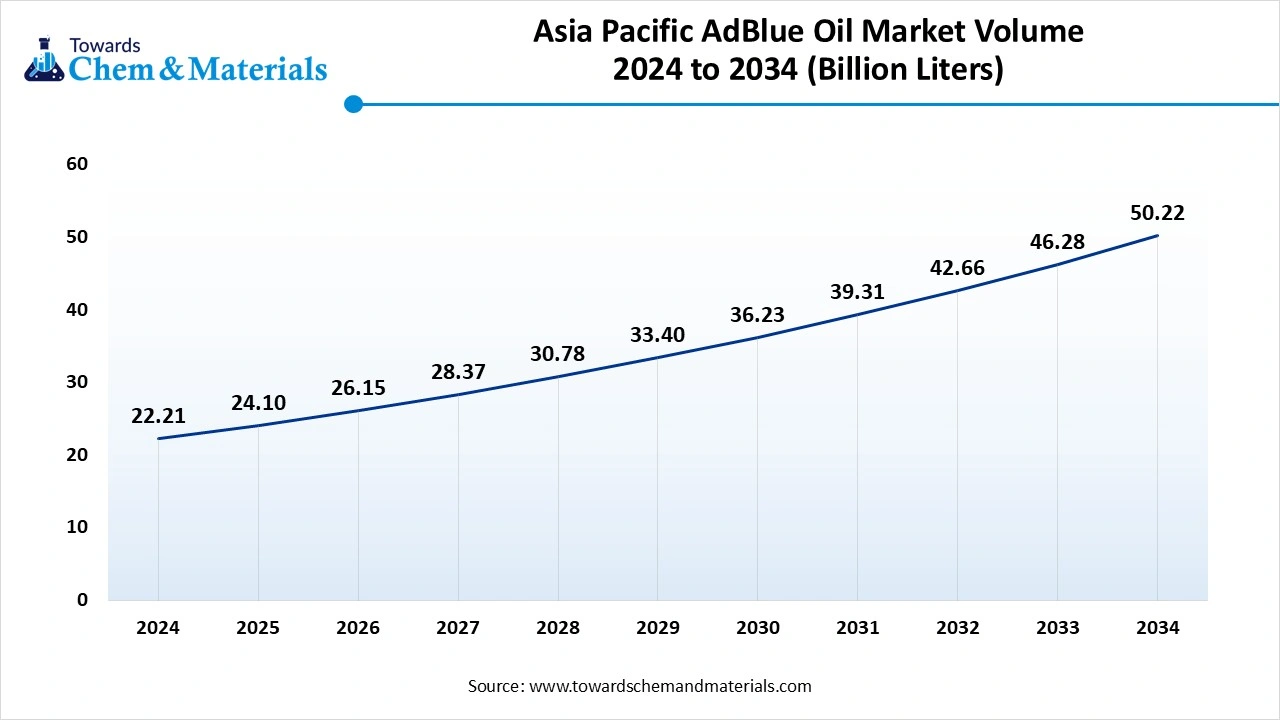
Asia Pacific Accelerates: Emerging Economies Drive AdBlue Demand, Asia Pacific is expected to grow at a significant pace in the coming period, akin to rising vehicle production, expanding transportation networks, and accelerating environmental regulations in countries such as China and India in the current period. Also, governments are actively pushing for cleaner diesel technologies, promoting SCR system adoption in the commercial sector, which has severely contributed to the demand for AdBlue oil in recent years. The growing industrialization and surge in diesel-powered vehicles in emerging economies contribute to increased AdBlue consumption. Furthermore, as domestic manufacturing capacities rise, regional suppliers are increasing production to meet demand.
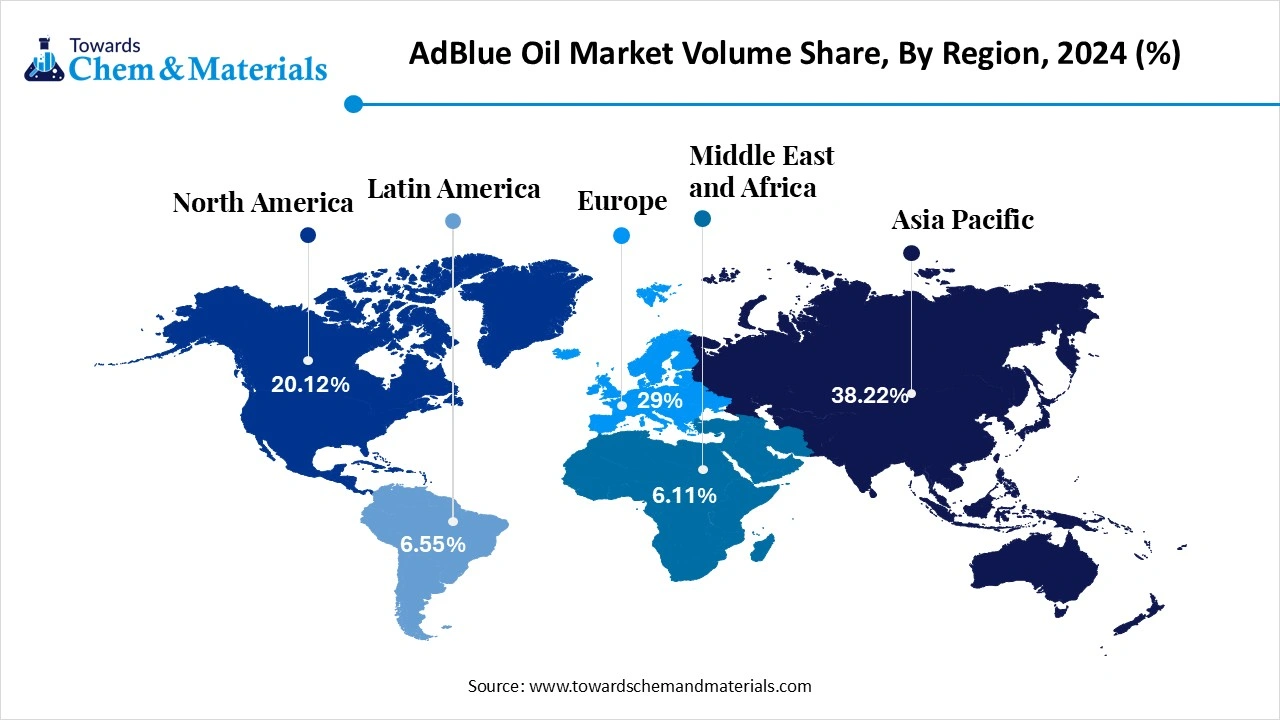
Green Mandates and Market Stability: Europe’s AdBlue Advantage, Europe expects notable growth in the market in future, akin to early adoption of sustainability policies and a mature regulatory framework. The region’s focus on decarbonization and strict Euro emission standards has long driven SCR implementation in both commercial and passenger vehicles in the region. However, supply chain challenges such as high energy costs and regional production disruptions have occasionally impacted availability and pricing in Europe. Despite this, the strong policy backing and consumer attention on green mobility have sustained consistent demand in recent years. Europe’s adoption of alternative fuels and electrification introduces uncertainty, but AdBlue remains important for existing diesel fleets in the current period.
AdBlue Oil Market Volume Share, By Region, 2024-2034 (%)
| By Region | Volume Share, 2024 (%) | Volume Billion Liters - 2024 | Volume Share, 2034 (%) | Volume Billion Liters - 2034 | CAGR (2025 - 2034) |
| North America | 20.12% | 15.41 | 18.34% | 27.21 | 5.85% |
| Europe | 29.00% | 22.21 | 33.21% | 49.27 | 8.30% |
| Asia Pacific | 38.22% | 29.27 | 33.85% | 50.22 | 5.55% |
| Latin America | 6.55% | 5.02 | 7.50% | 11.13 | 8.29% |
| Middle East & Africa | 6.11% | 4.68 | 7.10% | 10.53 | 8.45% |
| Total | 100% | 76.58 | 100% | 148.37 | 6.84% |
The railway trains segment dominated the market with the largest share in 2024, akin to the rising need for emission control in high-power diesel engines. Rail operators are seen adopting selective catalytic reduction (SCR) systems to meet stringent NOx emission standards while maintaining fuel efficiency. As long-distance trains and passenger trains depend heavily on diesel locomotion, consistent AdBlue usage becomes integral. Moreover, regulatory frameworks in Europe and Asia have accelerated compliance-driven demand, making railways a key application area.
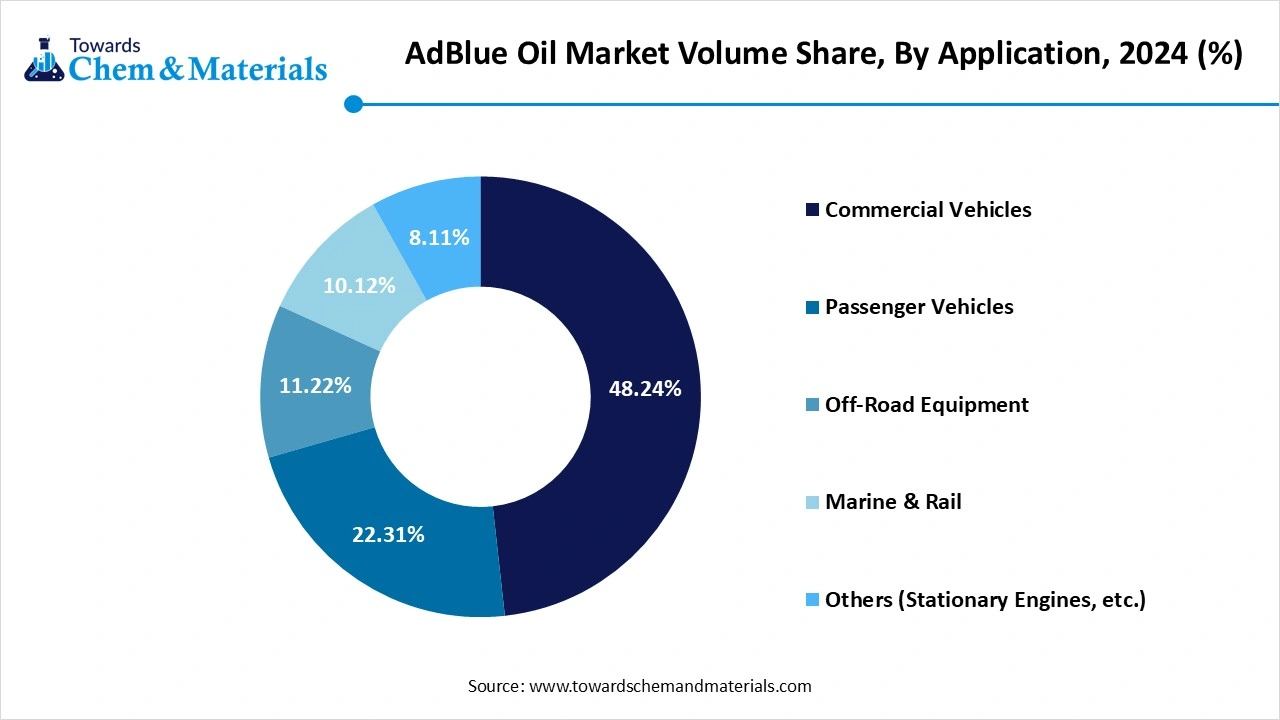
The commercial vehicle segment is expected to experience notable market growth in the future, owing to governments globally enforcing stricter emission regulations for heavy-duty transport. Fleets across logistics, construction, and municipal services increasingly integrate SCR technologies to align with evolving environmental standards in the current period. Moreover, the growing dependence on diesel-based movement, specifically in developing markets, fuels consistent AdBlue demand. Furthermore, fleet operators prioritize efficiency and regulatory compliance, leading to higher consumption patterns. With infrastructure expansion and e-commerce growth boosting road vehicle volumes, which is expected to drive the growth of the market during the upcoming years.
AdBlue Oil Market Volume Share, By Application, 2024- 2034 (%)
| By Application | Volume Share, 2024 (%) | Volume Billion Liters - 2024 | Volume Share, 2034 (%) | Volume Billion Liters 2034 | CAGR (2025 - 2034) |
| Commercial Vehicles | 48.24% | 36.94 | 47.64% | 70.68 | 6.70% |
| Passenger Vehicles | 22.31% | 17.08 | 20.03% | 29.72 | 5.69% |
| Off-Road Equipment | 11.22% | 8.59 | 13.11% | 19.45 | 8.51% |
| Marine & Rail | 10.12% | 7.75 | 9.22% | 13.68 | 5.85% |
| Others (Stationary Engines, etc.) | 8.11% | 6.21 | 10.00% | 14.84 | 9.10% |
| Total | 100% | 76.58 | 100% | 148.37 | 6.84% |
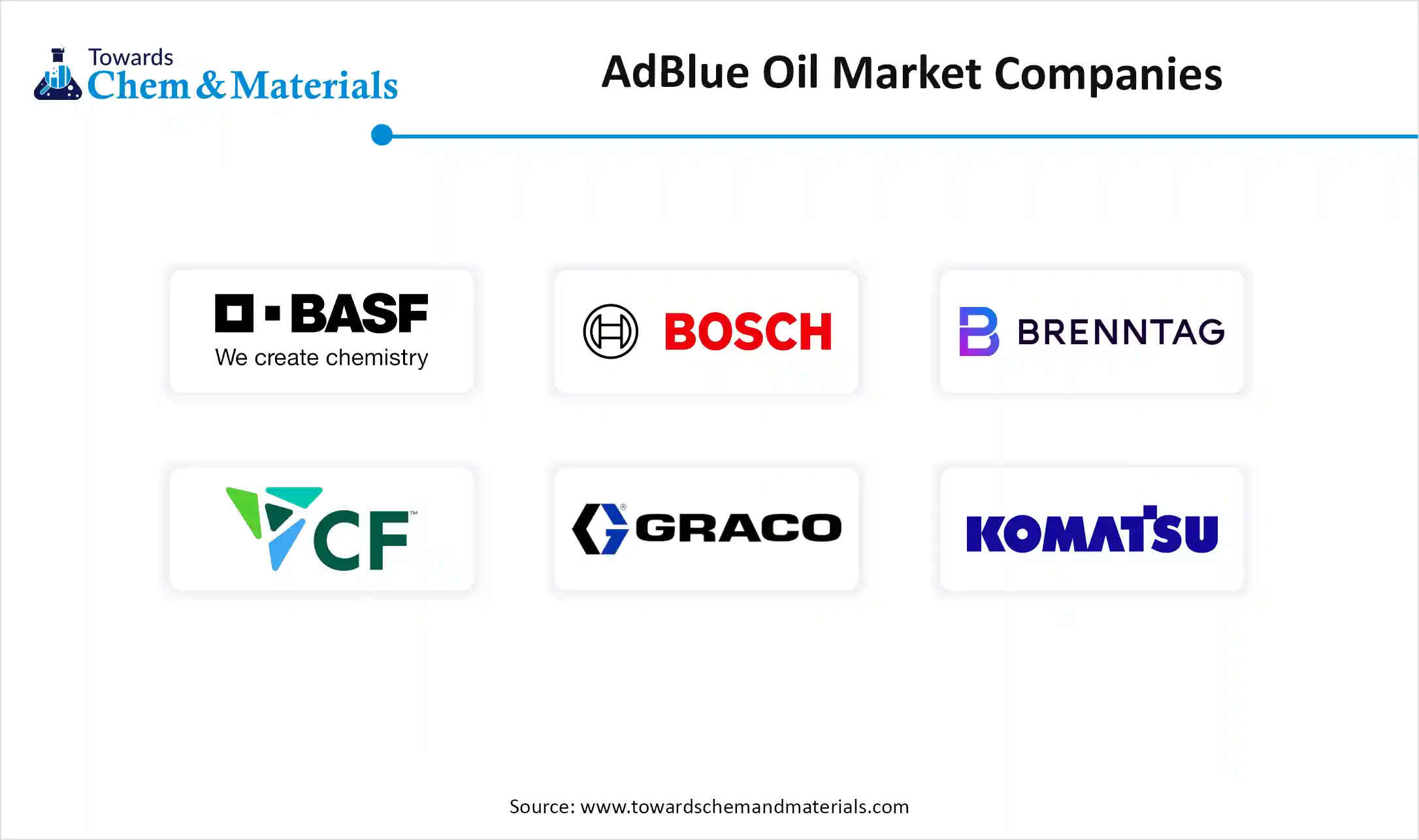
By Application
By Region
November 2025
November 2025
September 2025
September 2025